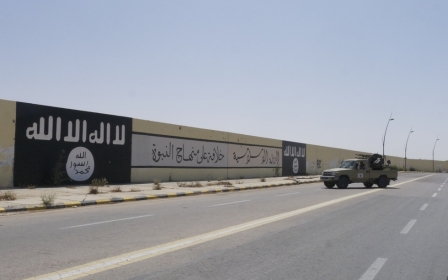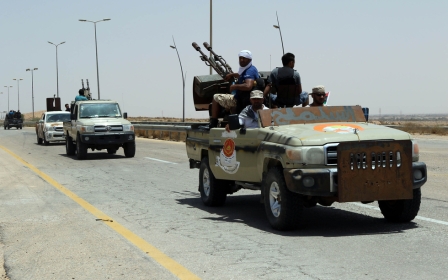Islamic State deploys female snipers in desperate bid to hold Libya's Sirte

The Islamic State (IS) in Libya is employing women as snipers in a surprising move by the group, which normally urges female followers to marry its fighters and establish families in self-proclaimed caliphate territories, rather than engage in active combat.
As Libyan forces, operating under the UN-backed Government of National Accord (GNA), battled IS to seize control of the sprawling Ougadougou complex in the former hometown of Muammar Gaddafi, one soldier said he was astonished to spot a female sniper.
“I couldn’t believe my eyes when I saw the woman. It was extraordinary,” fighter Ali Zeid told MEE. “She was 300 metres away on the top of the building, and she was shooting directly at me.”
As Zeid took cover, he said he could clearly see the female sniper each time she stood to take aim. “She was a big, tall woman, like a gladiator, and she looked Arab,” he said, adding that the woman was not fully covered with the black abaya and niqab IS has forced women to wear in Sirte. “She was wearing black trousers and a light grey shirt, with just a loose headscarf and I could clearly see her hair,” he said.
Zeid described the woman, who manned an FN machine gun, as an able but not brilliant marksman. She had obviously been trained because she hit one of his comrades in the leg.
Other fighters confirmed that there were at least two women on the frontline that day, because they could hear them shouting to one another inside the complex and one even called out to the Libyan fighters, telling them to go home.
As dusk fell, the Libyan troops were forced to withdraw until the next morning. They later received an intelligence report that 17 IS militants had been monitored leaving the complex under the cover of darkness.
As fierce fighting has continued in Sirte, boosted since early August by more than 150 US air strikes, Libyan fighters confirmed IS militants - now penned inside two square kilometres of central Sirte - have begun to employ more female snipers.
“We killed several snipers in the half-built Indian Buildings in Sirte and discovered afterwards that two of them were women,” said tank driver Hamed, 20. “I felt bad when we found the bodies. I was manning a gun that day and I hope it wasn’t one of my bullets that killed them.” He said one of the slain women was dressed in man’s army clothes, while the other wore a black abaya.
Although images of black-clad women wielding Kalashnikovs have been widely circulated as part of IS’s online propaganda, the role of women within the group is predominantly to serve the needs of male militants as wives, establishing family units to populate self-proclaimed caliphate territories. In IS strongholds, including Mosul in Iraq and Raqqa in Syria, a few also serve in an all-women morality police unit, known as al-Khansaa Brigade.
Libyan Field Commander Mohammed Issa, heading one of the frontlines in Sirte, also confirmed the presence of women fighters among IS’s ranks, saying they had been heard communicating on intercepted IS radio channels. “We know there are women fighting with IS here because we hear them talking on the radios sometimes, although we don’t know the numbers,” he said, adding that there were also children fighting with IS in Sirte.
Intelligence pictures gathered from drone surveillance operations showed women operating the smallest type of mortar used by IS, another fighter said.
One unit received their first warning that IS was employing women in the fighting several months ago from an interrogation session with a wounded IS militant who had surrendered. “He told us Daesh had 16 women in Sirte fighting alongside the men,” said Mohammed, a Libyan soldier present at the interrogation, after which the wounded militant reportedly died.
When a former al-Qaeda member visited Libyan forces in Sirte to offer advice on IS fighting strategies and explanations of their ideologies, the unit asked him what they should do if they found themselves face to face with a female enemy.
“Our religion does not allow us to kill women, so we wanted to know what we should do if we found ourselves fighting a woman,” he said. “He told us if she was fighting, we had to shoot her, but if we captured her, we must hand her over to the authorities.”
Issa said that although his unit had not directly encountered any female IS militants, they had found the group to be such an unpredictable enemy that they expect anything. “We would be very sorry to have to kill a woman, but what else could we do if one was trying to kill us?” he said. “This is a dirty, ugly war and some things are beyond our control.”
Several weeks ago, Libyan forces in central Sirte captured a woman suspected of being an IS militant. “We saw this woman coming out of a building in Sirte’s District One with her children,” Zeid said. “The front of her dress was covered in dust, which made us suspect that she had been lying on the ground shooting at us, and when we went inside we found a rifle.”
Brigadier-General Mohammed al-Ghassri, spokesman for the military operation, confirmed the arrest of a Libyan woman - the widow of a slain Egyptian IS militant - but described her as a civilian, adding: “She didn’t exactly surrender, but suddenly found herself surrounded by our troops.” He said she was the only IS prisoner currently being held.
Al-Ghassri said he was unable to confirm or deny the presence of woman snipers in Sirte, but said several women and children suspected of being suicide bombers had been shot dead. “Daesh are now using their women and children as kamikazes, and unfortunately we had to kill a few of them, afterwards finding that their bodies had been loaded with explosives,” he said.
The almost five-month offensive to liberate Sirte and the surrounding area from IS, which controlled the town for more than a year, has left about 560 Libyan soldiers dead and more than 2,600 wounded. IS has defended its territory with a relentless campaign of suicide car bombs, mines, IEDs and snipers. Several of the suicide vehicles have had female passengers on board, giving the appearance that the cars were civilian vehicles.
Female body parts - including the remains of a hand wearing gold rings - were found scattered around the site of a explosion that targeted a field hospital, while another Libyan fighter said that he saw a dismembered women’s foot decorated with henna in the aftermath of a double-suicide attack on a logistics area and cafe used by the Libyan forces on the outskirts of Sirte.
This article is available in French on Middle East Eye French edition.
New MEE newsletter: Jerusalem Dispatch
Sign up to get the latest insights and analysis on Israel-Palestine, alongside Turkey Unpacked and other MEE newsletters
Middle East Eye delivers independent and unrivalled coverage and analysis of the Middle East, North Africa and beyond. To learn more about republishing this content and the associated fees, please fill out this form. More about MEE can be found here.





